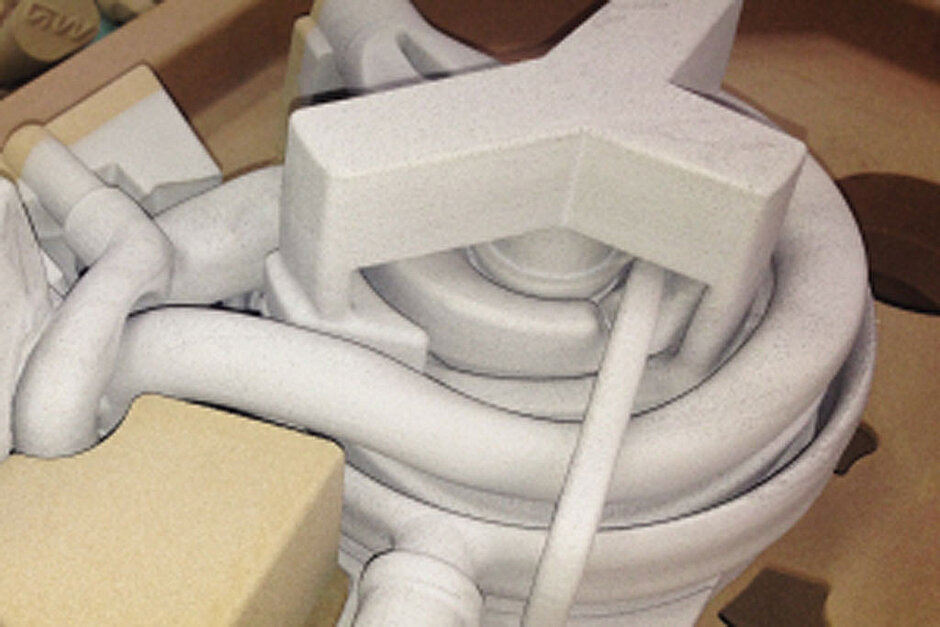Dating back some 2,000 years, sand casting is the epitome of established and traditional manufacture. However, the process is being given a boost by the current buzz-technology, 3D printing.
The installation of a large ExOne S-Print HHS at Shropshire-based family owned and run Grainger & Worrall, has allowed the company to modernise and offer an even faster turnaround service. While it did not come cheap, the £500,000 sand-printing equipment is being used to support its growing rapid prototyping business by producing sand cores and doing away with the need for hard tooling.
"We see ourselves as a provider of prototype, small batch and low volume castings," says Edward Grainger, director of Grainger & Worrall. "These are high integrity, high complexity structural castings that customers usually want quickly, as it is part of a development or design programme. The customer ends up with a fully assembled component that can be used for testing and devlopment, or actually sold.
"We are not mass manufacturing parts, we are making complex geometrical tools where there are significant challenges."
Examples of the company's work include high grade cast iron 6-cylinder truck engine blocks, at the heavier end, to its direct-to-line supply of series produced, assembled, fully tested and packaged aluminium engine blocks for a famous UK-headquartered luxury brand of saloon car. Both offer proof of its premier league credentials.
The proportion of business split across the company can vary, but currently the split is around one half in prototyping, with a fifth taken by motorsport and then series production accounting for the rest. Prototyping sees batches of 1 to 1,000 castings produced in any of the materials processed by the company that include aluminium, stainless steel and cast iron.
The majority of this prototype work is automotive-focused, with development driven by the push to reduce CO2 emissions. This means reduction in both size and weight, leading to a corresponding increase in unit loads, cylinder pressures, output torque and power density. As a result, the prototyping area takes a lot of work that is described as, 'R&D and risky'.
Modern pressures on automotive suppliers mean a need for fast lean prototype development. While 20 years ago a project might have taken 36-48 months to go from drawing board to production, "today, you have 12 months to do everything," says Keith Denholm, head of engineering at Grainger & Worrall. "So we've had to deploy technology to help us achieve that and the S-Print HHS investment now helps support our prototyping operation."
The casting process
Castings are produced using moulds and cores, assembled as core boxes into which molten metal is poured. Sand moulds deliver the outside contours and are produced via patterns. Sand cores deliver the cavities, bores and galleries. And to produce both the patterns and cores, tools must be produced.
The S-Print HHS is used for prototype sand core production, as well as the patterns for the external part contours. The machine is driven by CAD data and puts down layers of 0.2mm sand mixes, with a layer able to be put down every 40s.
The machine can employ a phenol bonding system, which remains strong even at elevated temperatures. The phenol system requires pre-heated sand with cores subsequently cured to achieve the necessary high bond strength.
Fundamentally, the systems at Grainger & Worrall underpin very fast turn-around prototype casting manufacture. They also offer a capability to produce complex cores that might otherwise demand multi-part cores. From receipt of CAD data, the company could be casting within 24 hours. In comparison, the traditional route, requiring both the CAD-based design of tooling plus the manufacture, would likely see the cast part take over a week. The company has now undertaken over 150 projects using the S-Print HHS, with heads, blocks and turbochargers being the main focus.
Of course, rapid prototype core production is no good without a comparably fast method of checking parts, so complementing the sand printer investment has been additional spend on metrology kit, housed in an adjacent area.
For repeat parts, however, hard tooling still has the edge in most cases, since producing cores from hard tooling offers a faster production cycle time. While 3D printing is not a major threat to established techniques, it does offer rapid turn-around for prototyping parts or very complex cores.
Grainger & Worrall clearly has its sights set on maintaining a leading position at the forefront of castings technology. While a traditional and established process, the knowledge to engineer and manufacture high performance castings on the shortest possible lead times is a skill very much of today and, indeed, tomorrow.
UK castings industry at a glance
- The UK makes around a billion metal castings every year
- These range from being over 300 tonnes to less than 1g
- The UK foundry industry has bounced back after an extraordinary dip during the 2008 recession
- Output in 2013 was around the same as pre-recession 2008 levels, in terms of tonnage and value
- There are over 400 foundries in the UK producing 523,000 tonnes of castings
- The sector has a turnover of £2.2billion and employs 17,000 people
Ceramic cores
Grainger & Worrell has worked with the Southwest Research Institute based in San Antonio, Texas, to develop a hybrid ceramic-sand core casting technology to support the push to smaller and lighter castings. Ceramic-sand remains stable at higher temperatures and can be produced in thinner sections compared with normal sand. However, its drawback is a lower rate of heat transfer.
Grainger & Worrall is a joint patent holder for the technique and, while it is not yet fully industrialised, when it is very few companies will be able to offer the service.
###COMPANY_LINK### <link http: www.materialsforengineering.co.uk _blank external-link-new-window external link in new>![]() www.materialsforengineering.co.uk
www.materialsforengineering.co.uk


